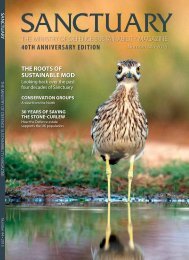SUSTAINABILITY
UBUt5
UBUt5
Create successful ePaper yourself
Turn your PDF publications into a flip-book with our unique Google optimized e-Paper software.
FEATURES<br />
linked to the militar y use of the area<br />
were also found. Amongst these<br />
smaller items were but tons and<br />
badges representing<br />
commonwealth nations, as well as<br />
units of the British Army. A small<br />
number of spent car tridge cases<br />
were also uncovered. From the<br />
markings on these, it is possible to<br />
ascer tain that the area was in use<br />
prior to W WI and also during W WII.<br />
A selection of American WWII<br />
cartridge cases was also found. These<br />
do not conclusively prove that<br />
American soldiers were based here, as<br />
the British Army also used American<br />
weapons. However, prior to D-Day in<br />
1944 large numbers of American<br />
soldiers were known to have been<br />
based at and trained on Salisbury Plain.<br />
A variety of other artefacts were<br />
discovered, including part of an<br />
armoured vehicle periscope, the lid of<br />
a coke stove, the key fob to a NAAFI<br />
building and a selection of horse shoes<br />
of varying sizes.<br />
After the dig – the school children went<br />
on to research the lives of the soldiers<br />
from this conflict in the cemeteries that<br />
surround the Plain, and also to write<br />
about the horses that had been there.<br />
Perhaps inspired by their finds, by<br />
reading ‘War Horse’ or by meeting<br />
serving and veteran soldiers they<br />
designed their own trench scenes, wrote<br />
moving poetry and in one case even<br />
build a war horse. The team were able to<br />
Julian examining the children’s findings © Harvey Mills<br />
examine real artillery pieces from the<br />
Great War and to sample the ‘delights’ of<br />
recipes from this period.<br />
The success of ‘War Horse’ also<br />
transferred to a film and to the National<br />
Theatre, and puppeteers trained by the<br />
latter visited a number of the schools<br />
involved in the MOD project to help<br />
them write their own shadow puppet<br />
stories based around their discoveries<br />
and their studies of WWI.<br />
There is no bet ter connection to the<br />
War than being able to physically find<br />
the traces lef t in the soil and being<br />
able to imagine the stories relating to<br />
an artefact. Through research,<br />
fieldwork and presentations, the team<br />
gained a better understanding of the<br />
role of artiller y in the Great War, of the<br />
role of horses, and recognised the<br />
importance of commemoration.<br />
Ever yone was able to gain a tangible<br />
insight into the landscape and its<br />
population at the star t of W WI<br />
through objects lef t behind. Most<br />
importantly perhaps, the project<br />
highlighted how essential the Plain<br />
has been to the militar y for a ver y<br />
long time and how all communities<br />
that live and work around this<br />
wonderful area can come together<br />
and remember.<br />
Richard Osgood<br />
Senior Archaeologist<br />
Defence Infrastructure Organisation<br />
Horse hospital findings © Harvey Mills<br />
Children recreate their own War Horse shadow puppet stories © Harvey Mills<br />
Sanctuary 44 • 2015<br />
13



